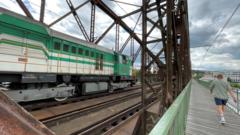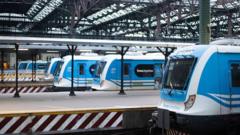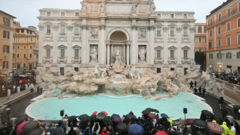The proposed replacement of Prague's 123-year-old Vysehrad railway bridge has sparked outrage among preservationists and locals, who argue for restoration over demolition. As the Railway Authority cites safety concerns, a coalition of experts strives to find a middle ground that honors the city's architectural legacy while accommodating modern travel demands.
Controversy Erupts Over Vysehrad Bridge Replacement in Prague

Controversy Erupts Over Vysehrad Bridge Replacement in Prague
Prague's historic Vysehrad railway bridge faces scrutiny as plans for its demolition emerge, igniting fervent debates on heritage and transportation needs.
The historic Vysehrad railway bridge in Prague, a crucial piece of the city’s architectural fabric, is under threat as plans for its replacement gather momentum. At 123 years old, this landmark bridge, which represents a significant industrial achievement from the Austro-Hungarian era, has become a flashpoint for debates surrounding the preservation of cultural heritage against the backdrop of modern transportation needs.
Architect Petr Tej, who is part of the Vysehrad Bridge Foundation, passionately defends the bridge’s importance. “The panorama it forms with the Vysehrad fortress is just as vital as that of the Charles Bridge and Prague Castle,” he asserts. Tej and his colleagues argue that instead of dismantling this iconic structure, it could be restored in place, minimizing disruption to the existing rail service and offering a more cost-effective solution.
Their claims are bolstered by a petition signed by over 25,000 residents, along with a report citing that only 15% of the original steel would need replacement, contrasting sharply with the Railway Authority's earlier assessments suggesting a 70% overhaul. They contend that historical preservation does not inherently conflict with the necessity for modernized transport infrastructure.
On the other hand, the Railway Authority's construction chief, Pavel Paidar, has expressed concerns over the bridge's structural integrity. He warns that the bridge, currently handling three-quarters of Prague's railway traffic, is increasingly unable to meet future transportation demands, signaling a looming crisis if not addressed.
Plans for a new bridge proposed by the authority would integrate a third track and aim to enhance transport links throughout the region. However, critics of this approach worry that relocating the old bridge to the outskirts of the city may render it aesthetically unsuitable for its new environment.
Amidst this tug-of-war between modernization and tradition, philanthropist Tomas Bistricky insists that an effective solution could simultaneously respect Prague’s historical legacy while accommodating future transport needs. “There is no inherent conflict,” he argues, suggesting a slender new bridge built alongside the original could satisfy both sides.
As this dilemma unfolds, it remains clear that the future of the Vysehrad railway bridge should not solely be decided by engineers or campaigners but will ultimately lie in the hands of the Czech government. The debate continues to surface fundamental questions surrounding the balance of progress and preservation in a city renowned for its historical significance.




















